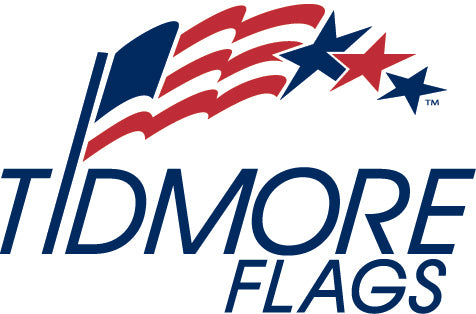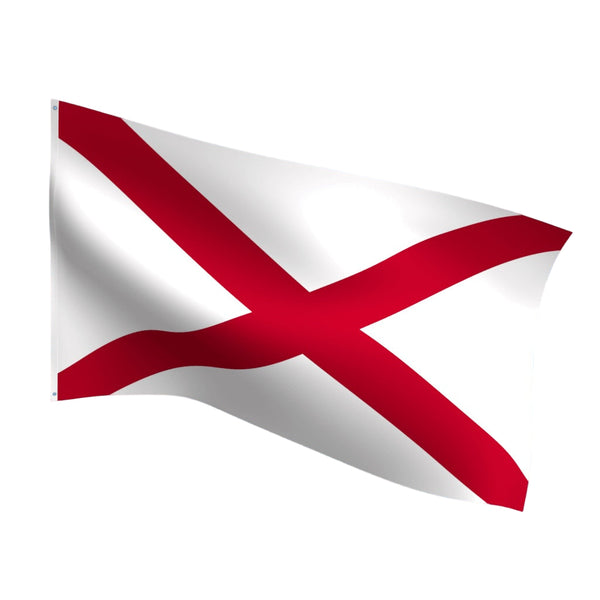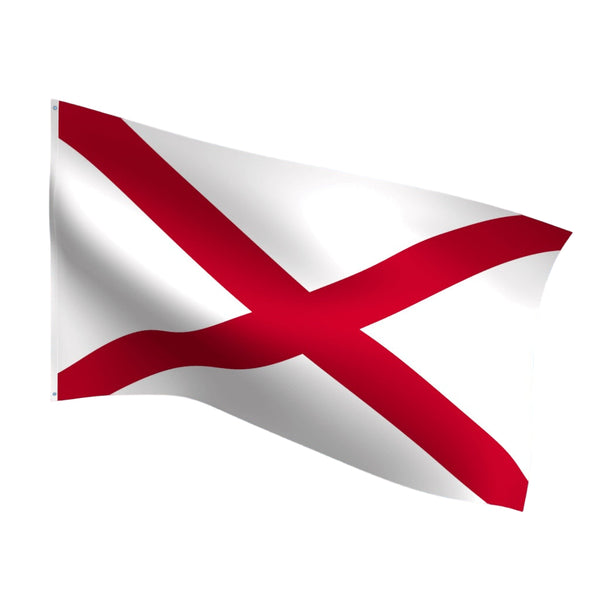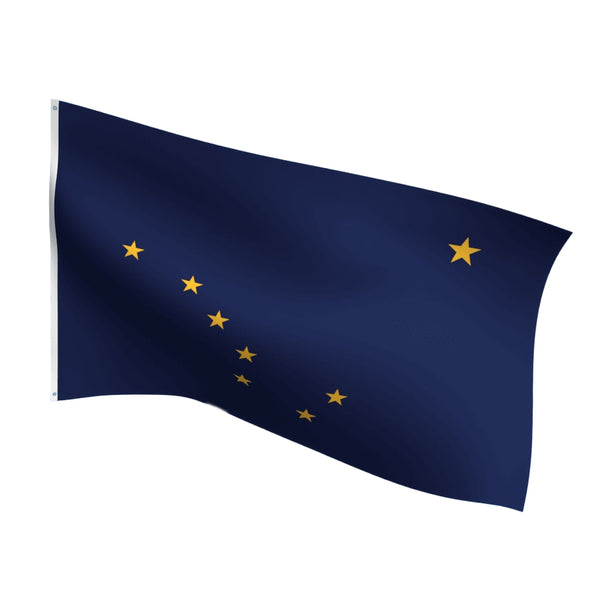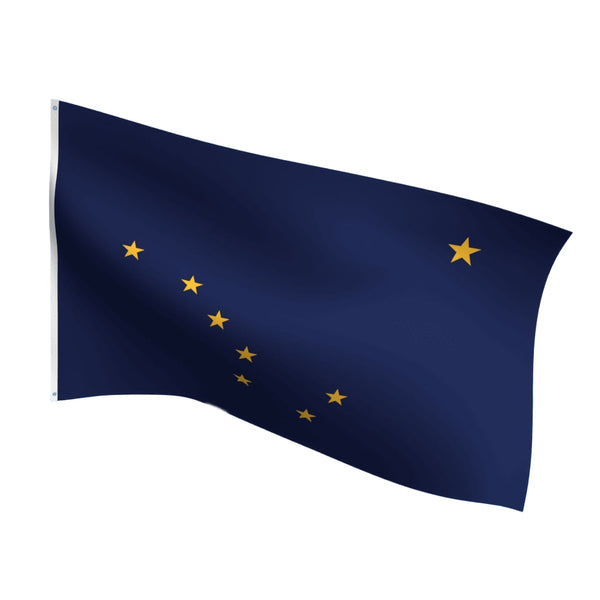Wind & High UV: The Right State Flag Materials for Alabama through Georgia
Share
You raise the flag, step back, and—whoosh—wind grabs the fabric while the sun beats down like a spotlight. A month later the edges look tired, colors a little dull. Sound familiar? In much of the U.S., wind and high UV are the two forces that age a flag fastest. If you live in Alabama, Alaska, Arizona, Arkansas, California, Colorado, Connecticut, Delaware, Florida, or Georgia, this guide shows exactly how to choose materials and sizes that fly better and last longer—without guessing.
Quick check: in your neighborhood, do you battle steady wind, intense sun, or both?
The Fast List: What to Buy When Wind & UV Are High
Use this as your 30-second cheat sheet before we dive deeper:
- Nylon (outdoor): Best all-around. Flies in light breeze, dries fast after rain or dew, vivid color.
- 2-Ply Polyester (outdoor): Tougher, heavier weave for steady wind, open terrain, or coastal abrasion from salt.
- UV reality: High-elevation or southern sun fades any fabric. Rotation + rinsing salt/dust = longer life.
- Indoor (presentation): Pole sleeve with optional gold fringe; keep out of direct window UV if possible.
-
Size vs. pole:
- 10–15 ft pole → 2′×3′
- 15–20 ft pole → 3′×5′ (most homes)
- 20–25 ft pole → 4′×6′
- 25 ft pole → 5′×8′
A Short Story About Beating the Elements (Florida Panhandle)
A marina customer on the Florida Panhandle wrote us every spring: “Same flag, same pole, new summer.” Their nylon flag looked fantastic in April—but by July the combo of sea breeze + salt + brutal UV had it fraying fast. We switched them to 2-ply polyester for summer and suggested a two-flag rotation (nylon in calmer shoulder months, polyester in peak wind/salt). The following year they emailed a one-liner: “That rotation strategy paid for itself.”
Moral: Match fabric to seasonal wind and UV exposure, and keep two flags—one flying, one resting.
State-by-State Guidance (A–G): Wind & High UV
Below you’ll find targeted advice for [state] wind and high UV conditions—what to fly, why, and where.
Alabama — Humid Heat, Thunderstorm Gusts
Best pick: Nylon for most homes (flies well in lighter morning/afternoon breezes). Step up to 2-ply polyester in open farmland or near large lakes where summer storms bring frequent whipping.
UV notes: Gulf sun is powerful. Rinse pollen/dust; rotate two flags mid-season for fresher color.
Sizes: 3′×5′ on a 15–20 ft pole; 4′×6′ if you want a bolder look on 20–25 ft.
Alaska — Cold, Gusty, Low Sun Angle (But Reflective Snow)
Best pick: 2-ply polyester in coastal or wide-open areas; nylon inland where winds are moderate.
UV notes: UV is less intense than the lower 48, but ice crystals + winter wind abrade fibers. Rinse road grit, avoid ice-stiff flags in storms.
Sizes: 3′×5′ for most homes; 4′×6′ for civic sites with 20–25 ft poles.
Arizona — Desert Gusts, Extreme UV
Best pick: 2-ply polyester holds up better in intense UV and abrasive dust; nylon only if your site is sheltered and you want easier fly in light wind.
UV notes: This is a UV torture test. Rotate two flags; shade indoor displays from direct sunlight.
Sizes: 3′×5′ is standard; 4′×6′ on 20–25 ft poles for more presence.
Arkansas — Seasonal Thunderstorms, Varied Terrain
Best pick: Nylon for neighborhoods; 2-ply polyester for hilltops, ridgelines, and the Delta where wind runs long.
UV notes: Summer UV is significant. Quick freshwater rinse after dust storms or mowing helps.
Sizes: 3′×5′ on 15–20 ft; 4′×6′ for schools and larger parcels.
California — Coastal Salt + Inland Sun
Best pick: Split strategy. Coasts & high-wind valleys: 2-ply polyester. Inland suburbs: nylon for easy flying.
UV notes: High UV (especially SoCal & Central Valley). Rinse salt/dust weekly near the ocean.
Sizes: 3′×5′ for homes; 4′×6′ or 5′×8′ for civic/commercial poles.
Colorado — Mountain Gusts, High-Elevation UV
Best pick: 2-ply polyester for Front Range winds and high passes; nylon can work in sheltered cul-de-sacs.
UV notes: High altitude = strong UV year-round. Rotate flags and avoid over-sizing (bigger flags take more wind load).
Sizes: 3′×5′ on 15–20 ft; 4′×6′ for campuses/civic sites.
Connecticut — Coastal Nor’easters, Moderate Summer UV
Best pick: Nylon is excellent for most properties; upgrade to 2-ply polyester if your yard channels wind or you’re near the Sound.
UV notes: Not Arizona-level, but summer UV still fades. Freshwater rinse after storms and pollen season.
Sizes: 3′×5′ standard; 4′×6′ for 20–25 ft poles.
Delaware — Atlantic Gusts, Salt Spray
Best pick: 2-ply polyester stands up better to coastal abrasion and steady breezes; nylon inland.
UV notes: Coastal sun + salt calls for rinsing and rotation. Consider de-salting hardware periodically.
Sizes: 3′×5′ for most; 4′×6′ at municipal sites.
Florida — Wind + Salt + Max UV
Best pick: 2-ply polyester for most coastal/inland homes due to constant breeze and salt; use nylon only in well-sheltered inland neighborhoods.
UV notes: Among the harshest in the U.S. Rotate at least monthly during peak summer; keep a spare on deck.
Sizes: 3′×5′ on 15–20 ft; 4′×6′ or 5′×8′ for marinas and campuses.
Georgia — Humid Heat, Thunderstorms, Coastal Zones
Best pick: Nylon for Atlanta-area suburbs; 2-ply polyester for the coast, open farmland, or lakefronts with afternoon storms.
UV notes: Summer UV is potent. Rinse pollen and trim early fray on the fly end.
Sizes: 3′×5′ on 15–20 ft; 4′×6′ for 20–25 ft poles.
Why Wind & UV Wear Flags (and How to Fight Back)
- Wind load: Every snap and flutter flexes fibers. Heavier weaves like 2-ply polyester resist tearing in steady wind.
- UV radiation: Sun weakens fibers and desaturates dyes. High-elevation and southern latitudes are hardest on color.
- Salt & dust: Act like sandpaper on edges. Rinsing keeps fibers smoother and dyes brighter.
Three Habits That Extend Flag Life
- Rotate two flags. One up, one resting; swap monthly (or with seasons).
- Rinse & dry. Freshwater rinse after salt spray, dust, or pollen; air-dry fully before reflying.
- Right size for the pole. Oversized flags look grand—but take more wind load and wear faster.
Materials Matchup for “Wind and High UV”
Nylon (outdoor)
- Pros: Lifts in light wind, vivid color, dries fast after rain/dew.
- Use when: Wind is intermittent/light; site is sheltered; you value easy flying and bright look.
2-Ply Polyester (outdoor)
- Pros: Heavier yarns, tighter weave; resists tearing and abrasion; better in steady wind and salt.
- Use when: Coastal, open terrain, hilltops, or frequent storms; also where high UV is paired with wind.
Indoor (presentation)
- Pole sleeve with optional gold fringe. Keep out of direct sun through windows; rotate for ceremonies.
The “Better Flying, Longer Life” Checklist
- Choose nylon for light/variable wind; choose 2-ply polyester for steady wind/coastal.
- Match flag size to pole height (don’t oversize in windy areas).
- Use quality hardware (stainless/nylon snaps, good halyard, solid cleat).
- Add lighting if you fly at night.
- Keep a backup flag ready—rotation saves money over the year.
A Question for You
If you had to pick just one pain point where you live—constant wind or relentless UV—which one ruins your flags faster? Your answer determines whether you start with 2-ply polyester (wind) or nylon + rotation (UV with lighter breezes).
FAQs: Wind & High UV for Alabama through Georgia
Which material lasts longer in wind?
Generally 2-ply polyester. Its heavier, abrasion-resistant weave holds up better to constant flapping and coastal grit.
Which material looks brightest in calm conditions?
Nylon. It lifts in light breeze and shows color beautifully, especially on residential poles.
How often should I replace a flag in high UV areas (AZ, CA, FL, CO)?
Expect 3–6 months of outdoor life with steady use; rotation, rinsing, and right-sizing can extend that timeline.
Does elevation really increase UV damage?
Yes. In places like Colorado, higher altitude means stronger UV; colors fade faster without rotation.
What’s the best size for a 20-ft pole?
3′×5′ is standard. Go 4′×6′ for extra presence if your site isn’t especially windy.
Can I fly a state flag with the U.S. flag?
Yes. The U.S. flag occupies the position of honor (highest or at its own right). Keep state and other flags equal in size.
Final Picks by State (Quick Recap)
- Alabama: Nylon most homes; polyester for open/windy or lakeside.
- Alaska: polyester on coasts/open terrain; nylon inland.
- Arizona: polyester (desert wind + high UV); nylon only if sheltered.
- Arkansas: Nylon neighborhoods; polyester for ridgelines/Delta.
- California: polyester coasts & wind corridors; nylon inland suburbs.
- Colorado: polyester (mountain gusts + high-elevation UV).
- Connecticut: Nylon most sites; 2-ply poly near the Sound or wind channels.
- Delaware: polyester on the coast; nylon inland.
- Florida: polyester almost everywhere (wind/salt/max UV); nylon only in sheltered inland areas.
- Georgia: Nylon inland; polyester for coast, lakes, or open farmland.
Ready to Fly Longer?
At Tidmore Flags, we stock USA-made state flags in both nylon and 2-ply polyester, plus indoor presentation sets, flagpoles, and accessories. Tell us your state, pole height, and local conditions, and we’ll recommend a setup that beats wind and high UV where you live.
Need help now? Visit TidmoreFlags.com — get the right flag, the right size, and the right material for your climate. Fly proud, fly smart.
